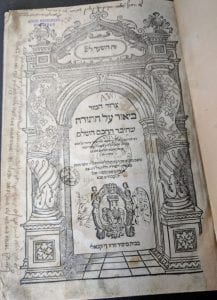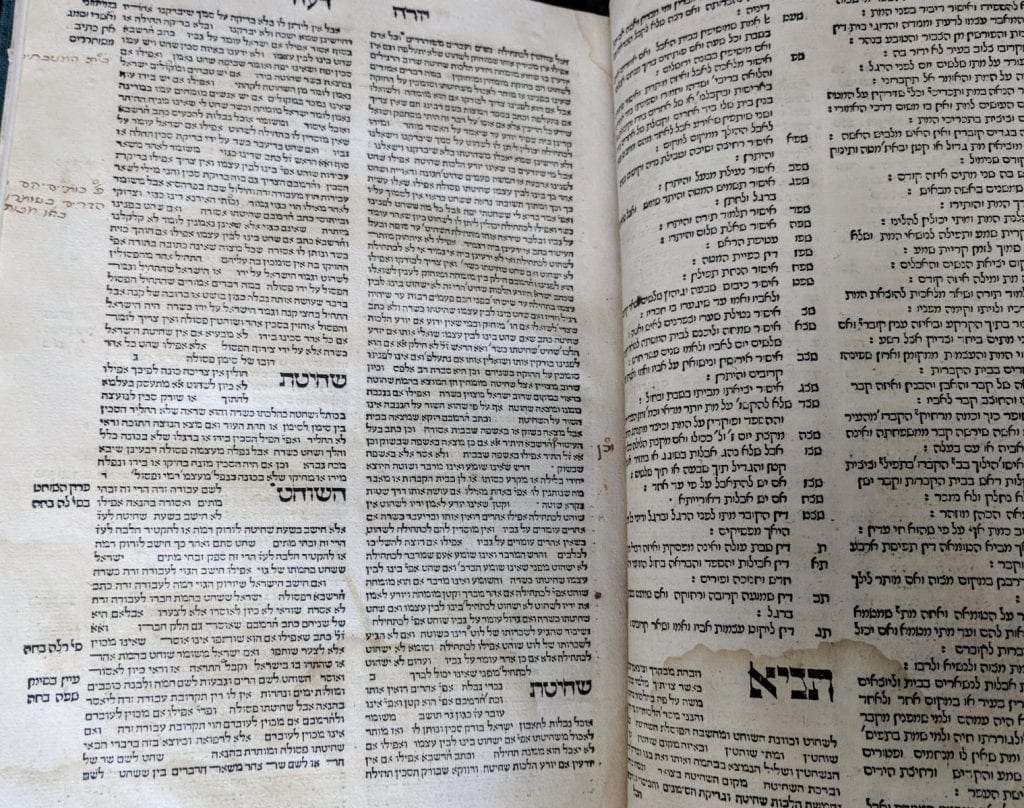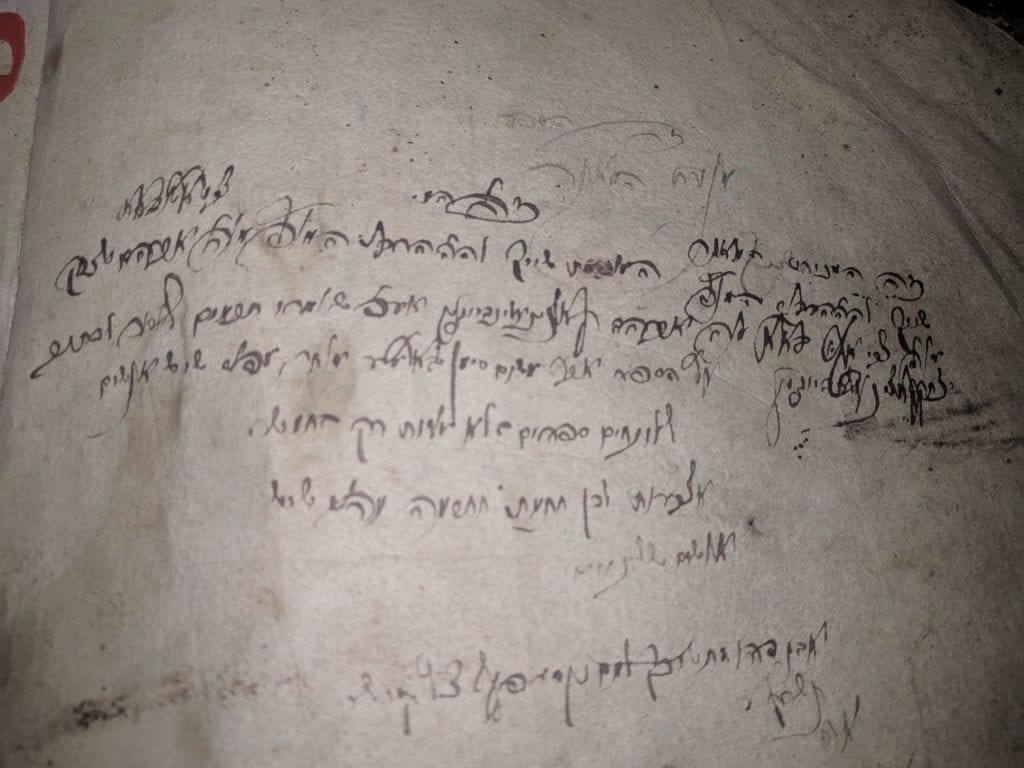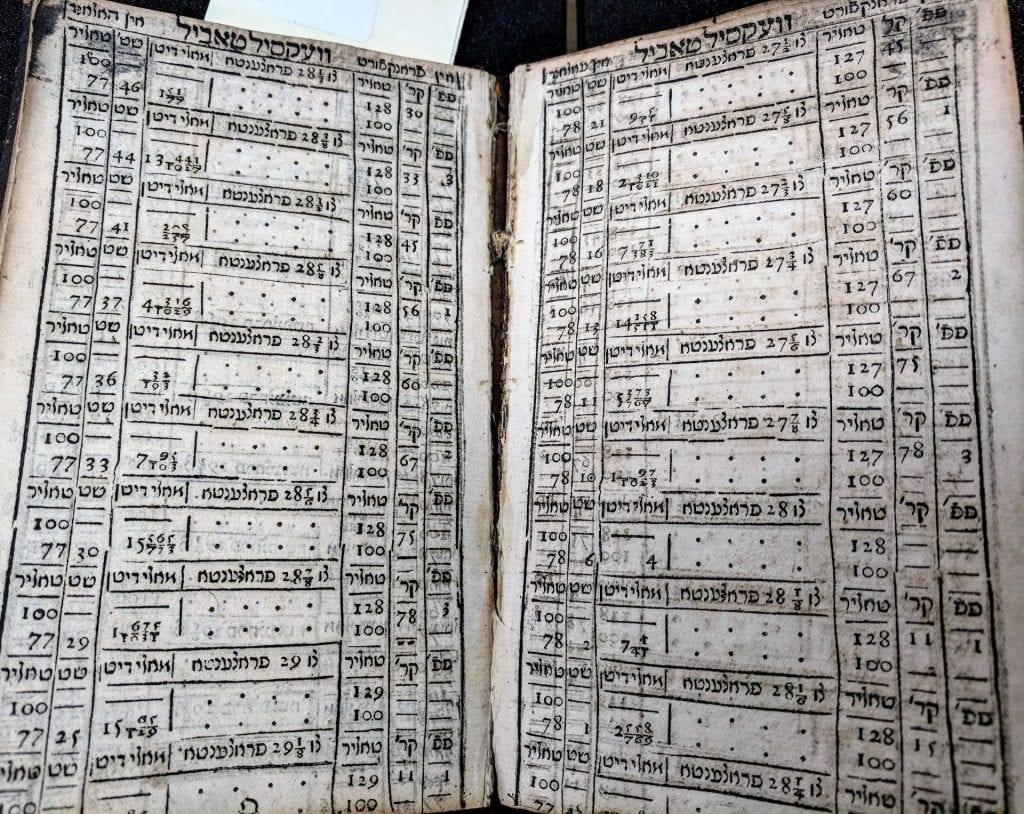Examples of Inscriptions, Censorship, Provenance, and Reconstruction
By: Chaim Meiselman
In this forum I hope to share some of the items and history I’ve uncovered at the Meyerhoff Collection at Towson University.
Along with my work of cataloging and describing the items in this collection, I have been collecting data about each books to add to Footprints. Below, I will share a selection of the items from this collection that I’ve shared with the Footprints project.
The Joseph Meyerhoff Collection is the product of the decades-long building of a rare Hebraica library: first at an institution known throughout the years as the Baltimore Teachers College, Baltimore Hebrew College, and Baltimore Hebrew University, and as of 2009, in its current location at the Towson University-Meyerhoff Collection.
 In April of 2018, I added a volume of Tseror ha-Mor by Abraham b. Jacob Saba, printed at Venice in February 1567 [1] by Giorgio de Cavalli. This is the third printing of this literary work.
In April of 2018, I added a volume of Tseror ha-Mor by Abraham b. Jacob Saba, printed at Venice in February 1567 [1] by Giorgio de Cavalli. This is the third printing of this literary work.
There is much evidence on this volume. Its footprints describe almost the entire life of this copy of the Tseror ha-Mor until its assumption into the Meyerhoff Collection.
The book includes the inscription of three generations of Parnasim and publishers of Hebrew Books in Fürth at the opening of the 18th century. Beginning with the ownership of Shmu’el Böenft Shnur (perhaps derived from the French “Bon Fit”, a translation of the Hebrew name “Yakar”), this volume was passed to his son Zalman, a prominent cantor and preacher at Mainz. Joseph son of Zalman received the volume after his father. A further Footprint with a long inscription describes a later owner who also carried the surname of this family of printers.
- The Meyerhoff collection includes books which carry the inscriptions of the “שלש קהלות”, the Tripartite Communities of Altona-Hamburg-Wandsbek; these inscriptions provide insight to the literary and bookselling environment of these communities.
Here is the inscription on the title of our copy of ‘Livyat Ḥen’ by Efraim b. Shmu’el Zanvil Hekscher, printed in Altona 1732-33 [2]:
The author of the volume, Efriam Hekscher, was a prominent figure on the Altona Bet-Din, along with the head of the Tripartite Community, Yehezkel Katzenellenbogen. The former was the publisher of the latter’s responsa. Katzenellenbogen’s books were printed at Altona, and because of this evidence within this copy, we can see them traveling to the other communities of the Tripartite.
Here is the Footprint describing the movement of the volume: from the author to his son to a Parnas in Wandsbek. The inscriptions indicate that the receiver gave it to his son as an inheritance.
- Our copy of Menorat ha-Maor, published in 1824 in Slavuta, Ukraine by the Shapira brothers, was among the books at the Offenbach Archival Depot during the Second World War. Previous to that, it was a gift (as a newly printed volume) to the Av-Beth-Din of “Brisk” (Best-Litovsk, Belarus), Avraham Katzenellenbogen.
- Our copy of Maʻaśeh ḥoresh ṿe-ḥoshev, published in 1711 in Frankfurt, begins on its page of Haskamot (approbations)[3]. This volume is a small Yiddish book written to teach mathematics and arithmetic, and carries tables of the exchange rates and some prices of items that would’ve interested a Jewish merchant.
Our copy is bound in its original boards and heavy leather binding, which withstood travel and heavy use. 
 It contains two inscriptions by the same owner: one in German at the rear and one in Hebrew at the front. These inscriptions record the buyer’s purchase of the volume for a friend, or perhaps for his father. The buyer records his travel from Poland to Peckelsheim, then a hamlet in Westphalia, Germany, using sentimental (and maybe once accented) German; it is noted in his inscription that he traveled from Poland to Germany. Perhaps he was a merchant, interested in exchange rates for Frankfurt and Holland (shown).
It contains two inscriptions by the same owner: one in German at the rear and one in Hebrew at the front. These inscriptions record the buyer’s purchase of the volume for a friend, or perhaps for his father. The buyer records his travel from Poland to Peckelsheim, then a hamlet in Westphalia, Germany, using sentimental (and maybe once accented) German; it is noted in his inscription that he traveled from Poland to Germany. Perhaps he was a merchant, interested in exchange rates for Frankfurt and Holland (shown).
- Finally, I cataloged a copy of Jacob b. Asher’s Arba’a Turim, published in Augsburg in 1540, by Hayyim Shahor. Our copy is white and fresh, and the beautiful fonts and inks are in excellent condition.

There are pages in this volume which are censored, and some heavily, such as on these leaves in Hilkhot ‘Avodah Zarah:
Appended to the end of the Towson copy are manuscript leaves roughly contemporary to the imprint. These leaves are water damaged; they have a stab-opening which pierced through all of the manuscript leaves. At the heading of the leaves is a damaged leaf in Polish script, which once belonged to a ledger, likely of a bookseller.
The volumes which make up the collection of rare books in the Joseph Meyerhoff – Towson University Collection have journeyed through many paths to reach their present home. Evidence of travel, war, the Holocaust, and American Jewish Studies has traveled with the volumes and continue to accompany them; the Footprints Project has given us a platform to trace and organize the provenance of these volumes.
[1] The exact date of printing is contradictory between the title information and that on the colophon. The title reads ’Shevat 327’, i.e. Feb. 1567, while the colophon reads ’ … today, sixth day (Friday), 5326 (1566)’ but does not include the month.
[2] Work started at the beginning of Elul (August-September) 1732, finished “Bekhi-Tov” Shvat (January) 1733. Likely “Bekhi-Tov” is referring to the closing of the month.
[3] It carries the approbations of Naphtali ha-kohen Katz (1649-1718) of Frankfurt, dated Tuesday 8 Tevet 1710; Samuel ha-kohen Schotten of Darmstadt, dated Friday, parashat Vayigash, 1710; and Hirsch Spitz Sega”l of Worms, dated Thursday 10 Tevet 1710.





Recent Comments